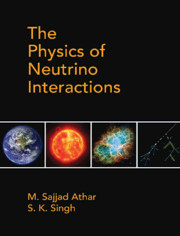Book contents
- Frontmatter
- Dedication
- Contents
- List of Figures
- List of Tables
- Preface
- Acknowledgments
- Chapter 1 Neutrino Properties and Its Interactions
- Chapter 2 Relativistic Particles and Neutrinos
- Chapter 3 Quantization of Free Particle Fields
- Chapter 4 Interacting Fields and Relativistic Perturbation Theory
- Chapter 5 Phenomenological Theory I: Nuclear β-decays and Weak Interaction of Leptons
- Chapter 6 Phenomenological Theory II: Weak Decays of Hadrons
- Chapter 7 Gauge Field Theories and Fundamental Interactions
- Chapter 8 Unified Theory of Electroweak Interactions
- Chapter 9 Neutrino and Electron Scattering from Point Particles
- Chapter 10 Neutrino scattering Cross Sections from Hadrons: Quasielastic Scattering
- Chapter 11 Neutrino Scattering from Hadrons: Inelastic Scattering (I)
- Chapter 12 Neutrino Scattering from Hadrons: Inelastic Scattering (II)
- Chapter 13 Neutrino Scattering from Hadrons: Deep Inelastic Scattering
- Chapter 14 Weak Quasielastic v(⊽)-nucleus Scattering
- Chapter 15 Inelastic Scattering of (Anti)neutrinos from Nuclei
- Chapter 16 Deep Inelastic Scattering of (Anti)neutrinos from Nuclei
- Chapter 17 Neutrino Sources and Detection of Neutrinos
- Chapter 18 Neutrino Mixing and Oscillations
- Chapter 19 Neutrino Astrophysics and the Synthesis of Elements
- Chapter 20 Neutrino Interactions Beyond the Standard Model
- Appendices
- Appendix A Lorentz Transformation and Covariance of the Dirac Equation
- Appendix B Cabibbo Theory
- Appendix C Some Properties of Pauli and Dirac Matrices and Spin Density Matrices
- Appendix D Leptonic and Hadronic Tensors
- Appendix E General Expression for the Total Scattering Cross Section and Decay Rates
- Appendix F Expressions of N(q2), the Coefficients of the Polarization Observables
- References
- Index
Chapter 12 - Neutrino Scattering from Hadrons: Inelastic Scattering (II)
Published online by Cambridge University Press: 22 May 2020
- Frontmatter
- Dedication
- Contents
- List of Figures
- List of Tables
- Preface
- Acknowledgments
- Chapter 1 Neutrino Properties and Its Interactions
- Chapter 2 Relativistic Particles and Neutrinos
- Chapter 3 Quantization of Free Particle Fields
- Chapter 4 Interacting Fields and Relativistic Perturbation Theory
- Chapter 5 Phenomenological Theory I: Nuclear β-decays and Weak Interaction of Leptons
- Chapter 6 Phenomenological Theory II: Weak Decays of Hadrons
- Chapter 7 Gauge Field Theories and Fundamental Interactions
- Chapter 8 Unified Theory of Electroweak Interactions
- Chapter 9 Neutrino and Electron Scattering from Point Particles
- Chapter 10 Neutrino scattering Cross Sections from Hadrons: Quasielastic Scattering
- Chapter 11 Neutrino Scattering from Hadrons: Inelastic Scattering (I)
- Chapter 12 Neutrino Scattering from Hadrons: Inelastic Scattering (II)
- Chapter 13 Neutrino Scattering from Hadrons: Deep Inelastic Scattering
- Chapter 14 Weak Quasielastic v(⊽)-nucleus Scattering
- Chapter 15 Inelastic Scattering of (Anti)neutrinos from Nuclei
- Chapter 16 Deep Inelastic Scattering of (Anti)neutrinos from Nuclei
- Chapter 17 Neutrino Sources and Detection of Neutrinos
- Chapter 18 Neutrino Mixing and Oscillations
- Chapter 19 Neutrino Astrophysics and the Synthesis of Elements
- Chapter 20 Neutrino Interactions Beyond the Standard Model
- Appendices
- Appendix A Lorentz Transformation and Covariance of the Dirac Equation
- Appendix B Cabibbo Theory
- Appendix C Some Properties of Pauli and Dirac Matrices and Spin Density Matrices
- Appendix D Leptonic and Hadronic Tensors
- Appendix E General Expression for the Total Scattering Cross Section and Decay Rates
- Appendix F Expressions of N(q2), the Coefficients of the Polarization Observables
- References
- Index
Summary
Introduction
The study of the various inelastic processes induced by photons, electrons,pions, and (anti) neutrinos from nucleons is very important as it providesinformation about the excitation mechanism of nucleons. This enables us toinvestigate the structure of nucleons as a composite of quarks and the roleof gluons in the quark–quark forces using quantum chromodynamics(QCD). The inelastic processes induced by (anti)neutrinos are a uniquesource to determine the axial vector aspects of the nucleon structure andrelate it to the pion physics. Moreover, in recent years, inelasticreactions induced by (anti)neutrinos leading to the production of mesonslike pions, kaons, and ηs have become more relevantin the search for proton decay and for neutrino oscillations.
Within the standard model, proton stability is associated with baryon numberconservation, as the proton being the lightest baryon, cannot decay into anyother baryon when it is in the free state. It is believed that the baryonnumber conservation law is not a fundamental law; and there are models ofgrand unified theory (GUT) [503], which predict the lifetime of the protonto be of the order of 1031 years. To estimate a proton'slifetime, some calculations have also been performed using supersymmetry(SUSY) GUTs like SUSY SU(5) and SUSY SO(10). Generally, SUSY GUT modelsfavor kaons (K0 orK+) in the final state if a protondecays. However, some of these models also predict decay modes where an etameson is produced in the final state [504]. In the minimal SU(5) GUT, thepredicted proton lifetime and decay to e+π0 is 1031±1 years,which has been ruled out by IMB [505], Kamiokande [506, 507], andSuper-Kamiokande [508]. Although these experiments have not observed anyevent for the decay p → e+π0, they have provided the limit for theproton's lifetime to be 1033±1 years. The bestlimit on the proton's lifetime comes from Super-Kamiokande [509] forthe channel p → νK+> 5.9 × 1033years. Soudan-2 [510] looked for eta in the final state in the proton years.Soudan-2 [510] looked for eta in the final state in the proton decaysearches and found the best limit for the channels p →μ+η and p →e+η to be 8.9 ×1031 years and 8.1 × 1031years, respectively.
- Type
- Chapter
- Information
- The Physics of Neutrino Interactions , pp. 478 - 506Publisher: Cambridge University PressPrint publication year: 2020

